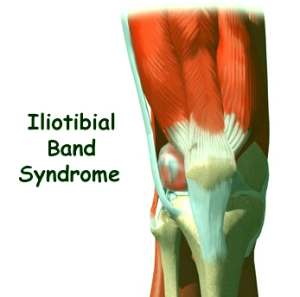Iliotibial band syndrome is an injury or damage of the tissues present on the outer region of the knee and the thigh. The injury primary results from overexertion or overuse. The condition leads to increased tenderness and pain of the affected regions, particularly just on top of the knee joint. Runners and cyclists generally develop the iliotibial band syndrome. The condition is also known as IT band syndrome or ITBS.
The solid band of tissue that starts at the iliac crest present in pelvis and travels towards the outer area of the thigh and which then passes the knee to fasten into the upper part of the shinbone is referred to as the iliotibial band. It performs the function of stabilizing the knee through its various motions.
When the knee is contracted, the iliotibial band is situated at the rear of the femoral condyle, which is a bony growth of the femur at the knee. When the knee is deflexed, then the iliotibial band gets forward across the femoral condyle. The gliding of the IT band across the condyle is aided by a sac. However, swelling of this region can result in increased pain due to persistent friction of the bony condyle against the IT band. The pain is more prominent along the outer regions of the knee joint.
It is important not to ignore the symptoms of iliotibial band syndrome, as it can lead to the increased swelling, scarring of bursa and pain in the area, which in turn can cause restricted motion of the knee as well as increased pain with diminishing levels of activity.

Iliotibial band syndrome symptoms
Some of the signs and symptom of iliotibial band syndrome are discussed below:
- The iliotibial band syndrome is generally associated with pain that is normally felt at the outer part of the knee where the IT band passes to and fro at the epicondyle of the thighbone. Such pain is usually caused due to inflammation of the region.
- The pain usually begins with needle-like prickly, stinging sensations, which individuals affected by iliotibial band syndrome do not give much attention. With the passage of time these sensations can progress into extreme pain when the heel hits the ground and eventually result in pain that has disabling effect while walking or during other activities like climbing up or down the stairs.
- A few patients of iliotibial band syndrome may experience popping or snapping sounds at the knee.
- Areas like where the knee connects to the tibia or where the IT band passes the femoral epicondyle may experience some swelling
- In some cases, individuals with iliotibial band syndrome may experience the pain radiating along the path of the IT band towards the outer part of the thigh and the hip
Causes of iliotibial band syndrome
Iliotibial band syndrome is a condition that is caused due to over exertion of the iliotibial band, and generally tends to occur in cyclists, long distance runners and other sportsperson who repetitively squat.
Iliotibial band syndrome may be caused due to a number of reasons or a combination of them, including decreased flexibility of the muscle, poor training techniques and other mechanical irregularities in the body.
The presence of certain anatomical abnormalities such as bowed legs, different lengths of each of the legs and an irregular slope of the pelvis, can also increase the risk to iliotibial band syndrome. Such anatomical anomalies can result in increased tightness of the iliotibial band, leading to increased cases of friction when the IT band moves back and forth across the epicondyle during motion and other activities.
Roads are generally built in such a way that the center part of the road is at a higher level than the sides to facilitate easy runoff of water. Runners who run on such surfaces exert the same pressure on the IT band, as that experienced by individuals with legs of different lengths. This can result in increased inflammation and development of iliotibial band syndrome.
Similarly, increased posture during cycling or weight lighting or other activities can increase the risk to developing iliotibial band syndrome.
Iliotibial band syndrome treatment
- The initial treatment for iliotibial band syndrome usually involves the RICE therapy, i.e., rest, ice, compression and elevation
- The doctor may also recommend the intake of anti-inflammatory medications.
- In case the above treatment methods do not work, then a physical therapist may be consulted, who then assist in decreasing the inflammation levels. The physical therapist will also evaluate various other factors that may be responsible for iliotibial band syndrome. The therapist will analyze the gait of the affected person by watching him/her walk or run, and check the muscle balance and strength as well as the flexibility. In case, there is a difference in the length of the legs, pelvic-tilt, etc., then the therapist may suggest Shoe orthotics, etc. for overcoming iliotibial band syndrome.
- Surgery is used as the last option to correct the symptoms of iliotibial band syndrome.